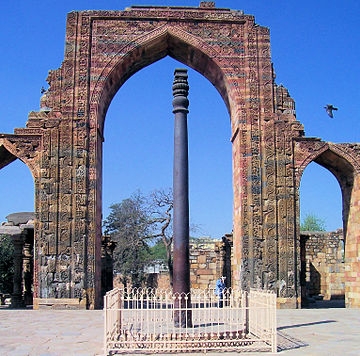
The Iron Pillar of New Delhi is famous for its rust-resistant facade. Measuring 23 feet and 8 inches in height, 16 inches in diameter, and weighing 3 tonnes, it stands in the Qutb complex at Mehrauli. The pillar has attracted the attention of archaeologists and materials scientists because of its high resistance to corrosion and has been called a “testimony to the high level of skill achieved by the ancient Indian iron smiths in the extraction and processing of iron”. The corrosion-resistance results from an even layer of crystalline iron hydrogen phosphate hydrate forming on the high-phosphorus content iron, which protects it from the effects of the Delhi climate. The oldest inscription on the pillar is that of a king named Candra, generally identified as the Gupta Emperor Chandragupta II (c. 375-415 CE).
The oldest inscription on the pillar is that of a king named Chandra (IAST: Candra), generally identified as the Gupta emperor Chandragupta II.
The inscription covers an area of 2?9.5? × 10.5?. The ancient writing is preserved well because of the corrosion-resistant iron on which it is engraved. However, during the engraving process, iron appears to have closed up over some of the strokes, making some of the letters imperfect.
It contains verses composed in Sanskrit language, in shardulvikridita metre. It is written in the eastern variety of the Gupta script. The letters vary from 0.3125? to 0.5? in size, and resemble closely to the letters on the Allahabad Pillar inscription of Samudragupta. However, it had distinctive m?tr?s (diacritics), similar to the ones in the Bilsad inscription of Kumaragupta I. While the edges of the characters on the Allahabad inscription are more curved, the ones on the Delhi inscription have more straight edges.
Picture Credit : Google




